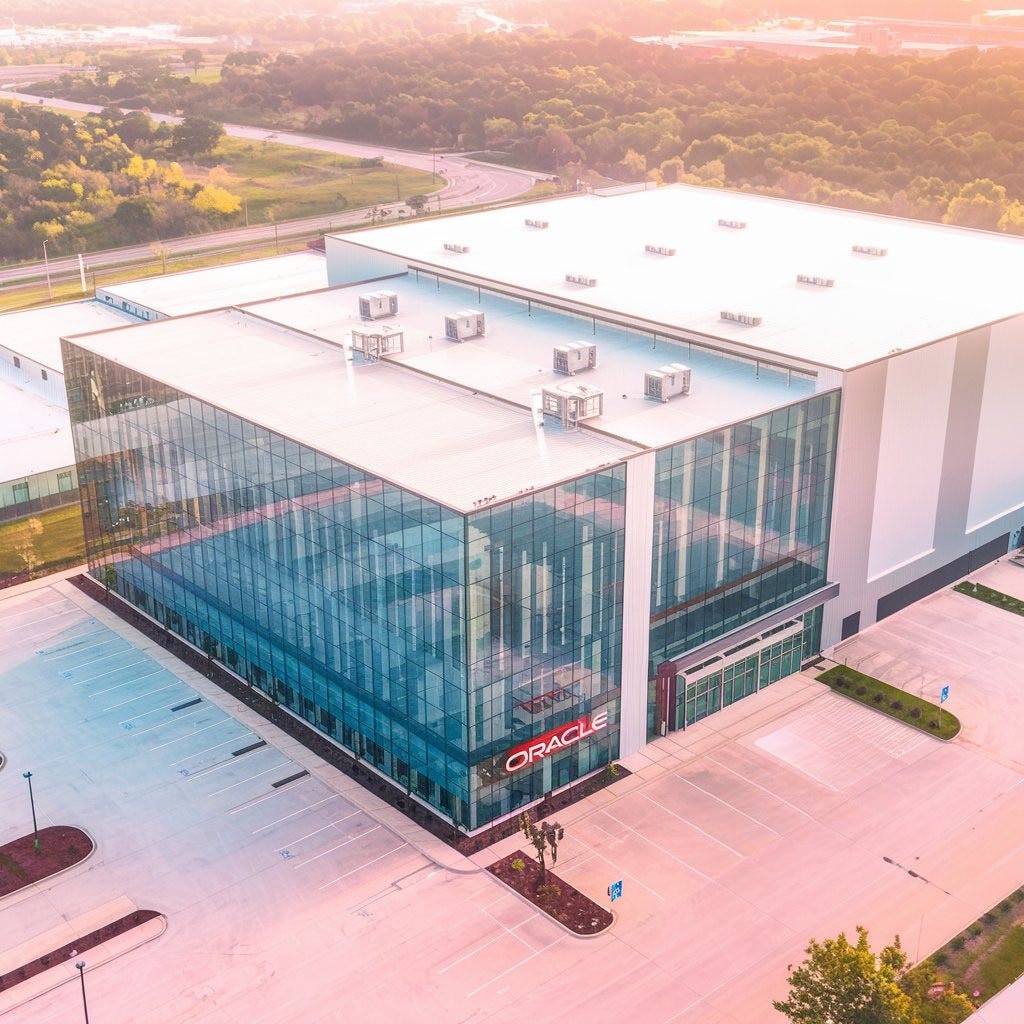Oracle’s $40 Billion Power Move: The Lease That Could Reshape the AI Cloud Hierarchy
A bold financial engineering play. A tectonic shift in AI infrastructure. And a quiet declaration of war on Microsoft’s AI supremacy.
Welcome to Global Data Center Hub. Join 1000+ investors, operators, and innovators reading to stay ahead of the latest trends in the data center sector in developed and emerging markets globally.
Oracle’s Entry Into the AGI Arms Race
Until now, Oracle wasn’t even considered part of the AI “Big 3” cloud club.
AWS. Azure. Google Cloud. Those were the players.
But with one stroke, a $40 billion commitment to Nvidia’s latest GB200 chips, Oracle may have just rewritten the future of artificial intelligence infrastructure.
Not by competing to build a better AI.
But by owning the compute rails every AI model must ride.
This isn’t just a chip deal.
It’s a 15-year strategic leaseback that places Oracle at the center of OpenAI’s most ambitious project: Stargate.
A New Business Model for the AI Era
Let’s unpack the real innovation here.
Oracle isn’t simply buying 400,000 of Nvidia’s most advanced chips (though that alone would be historic).
It’s leasing that compute to OpenAI over 15 years.
Why does that matter?
Because it turns the old cloud model on its head:
This deal is less like AWS, more like Blackstone.
Oracle is becoming a real estate investor in the AI economy, except the “property” is compute.
Stargate: The Facility That Changes the Game
The $40B deal fuels OpenAI’s Stargate campus in Abilene, Texas, a massive 875-acre site that will soon become the most powerful AI training facility ever constructed.
Key Specs:
400,000 GB200 chips
11,000 racks (NVL72 systems)
1.2GW of power draw
16 ZettaFLOPs of peak performance
Advanced liquid cooling
8 identical buildings over 2 construction phases
Phase 1 (200MW) will go live by mid-2025. Phase 2 (1GW) wraps up by mid-2026.
This isn’t hyperscale. This is AI industrial scale.
The difference?
Hyperscale cloud powers apps.
Stargate powers AGI.
Who’s Behind It?
The Stargate Project is a $500B mega-joint venture between:
OpenAI (40% equity, operational control)
SoftBank (40% equity, financial engine)
Oracle (infrastructure + chip financier)
MGX (Abu Dhabi) (sovereign capital + global scale)
With JPMorgan contributing $9.6B in loans, Crusoe + Blue Owl investing $5B in equity, and Oracle covering the chips, this is one of the most complex infrastructure financing stacks ever assembled for AI.
Even the name Stargate was chosen to reflect the ambition:
A portal to new worlds, not unlike AGI itself.
Microsoft’s Azure Grip Weakens
Why did OpenAI do this?
Because compute scarcity was killing innovation.
Microsoft’s $13B “investment” in OpenAI was mostly Azure credits, not cash. And with GPT-4’s training consuming massive GPU hours, OpenAI ran into bottlenecks.
Now, with Oracle’s chips and Crusoe’s data center, OpenAI gets:
Guaranteed compute
Fixed costs over 15 years
Escape velocity from Azure’s limitations
Make no mistake: this is a power play.
Not against Microsoft’s money, but its monopoly.
A Global Template: Stargate UAE + European Moves
The Texas Stargate is just the beginning.
OpenAI has already announced Stargate UAE:
5GW of power
2M+ GB200 chips
Built with G42 Cloud in Abu Dhabi
French President Emmanuel Macron countered with a €109B national AI plan.
This is no longer a U.S.-only race.
It’s a global infrastructure contest.
And the currency isn’t GPUs, it’s sovereign alignment, energy access, and industrial logistics.
Who Wins from Oracle’s Bet?
1. Oracle – Reinvents itself as the invisible platform for AGI compute. Not the model, not the app—but the rails.
2. Nvidia – Strengthens grip as the arms dealer of the AI economy.
3. OpenAI – Secures compute independence and optionality beyond Microsoft.
4. Crusoe + Blue Owl – Operational credibility + institutional capital = a seat at the new table.
5. Investors – Oracle’s stock is up 12% since May, and more infrastructure REIT-style models may follow.
Who Loses?
1. Microsoft – Its Azure exclusivity with OpenAI just ended.
2. Cloud providers stuck in “credits over chips” – The world is moving toward hard assets.
3. Startups relying on public cloud – Competing for GPU scraps is no longer viable at the frontier.
What’s Next?
We’re entering the Capital Era of AI, where the bottleneck is no longer talent or IP.
It’s:
Infrastructure
Power
Capital
Expect to see:
More sovereign wealth funds entering AI infrastructure
Institutional capital treating data centers like energy assets
Specialized SPVs, leaseback models, and asset-backed financing structures
Oracle’s deal is just the first chapter.
Final Thought
Oracle didn’t just spend $40B on chips.
It redefined what it means to “own” the future of AI.
And as the world races toward AGI, the companies who control compute, not just the models, will hold the keys to intelligence itself.
One More Thing
I publish daily on data center investing, AI infrastructure, and the trends reshaping global data center markets.
Join 1000+ investors, operators, and innovators getting fresh insights every day and upgrade anytime to unlock premium research trusted by leading investors and developers.

